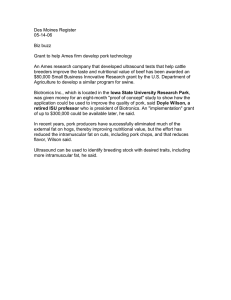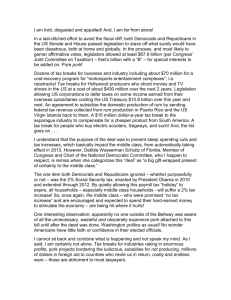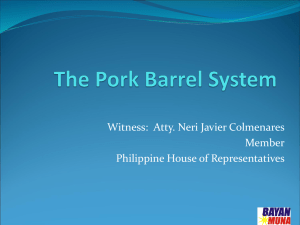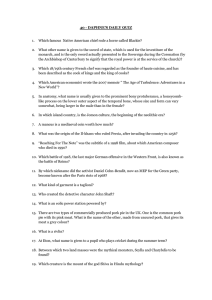Federal Document Clearing House Congressional Testimony July 12, 2006 Wednesday
advertisement
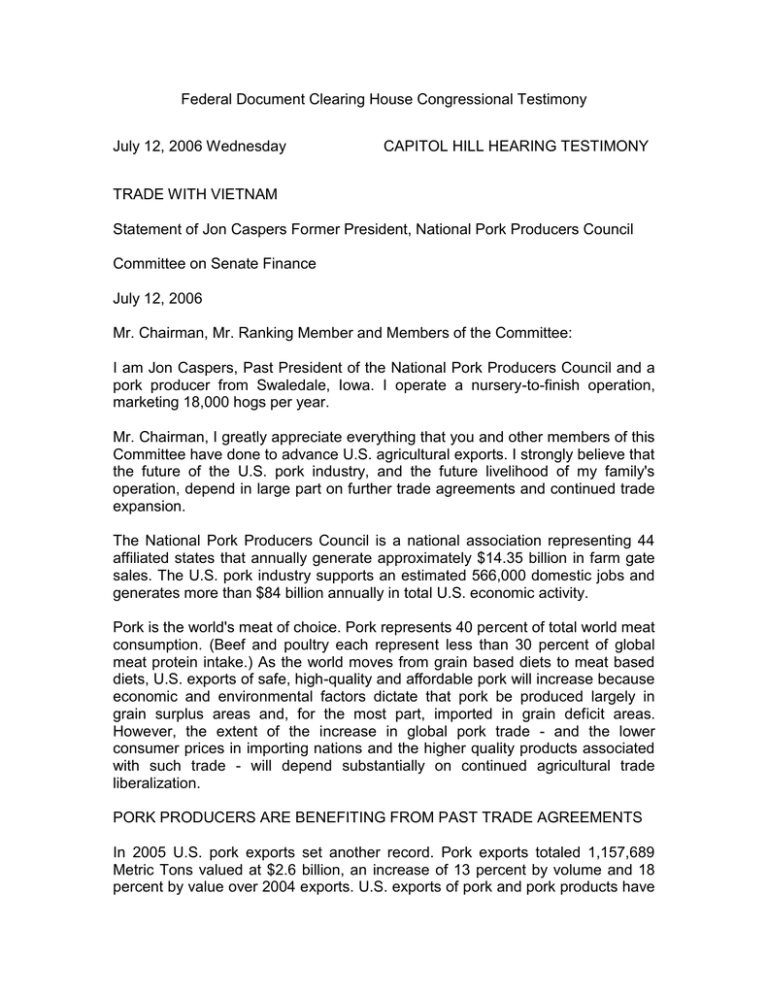
Federal Document Clearing House Congressional Testimony July 12, 2006 Wednesday CAPITOL HILL HEARING TESTIMONY TRADE WITH VIETNAM Statement of Jon Caspers Former President, National Pork Producers Council Committee on Senate Finance July 12, 2006 Mr. Chairman, Mr. Ranking Member and Members of the Committee: I am Jon Caspers, Past President of the National Pork Producers Council and a pork producer from Swaledale, Iowa. I operate a nursery-to-finish operation, marketing 18,000 hogs per year. Mr. Chairman, I greatly appreciate everything that you and other members of this Committee have done to advance U.S. agricultural exports. I strongly believe that the future of the U.S. pork industry, and the future livelihood of my family's operation, depend in large part on further trade agreements and continued trade expansion. The National Pork Producers Council is a national association representing 44 affiliated states that annually generate approximately $14.35 billion in farm gate sales. The U.S. pork industry supports an estimated 566,000 domestic jobs and generates more than $84 billion annually in total U.S. economic activity. Pork is the world's meat of choice. Pork represents 40 percent of total world meat consumption. (Beef and poultry each represent less than 30 percent of global meat protein intake.) As the world moves from grain based diets to meat based diets, U.S. exports of safe, high-quality and affordable pork will increase because economic and environmental factors dictate that pork be produced largely in grain surplus areas and, for the most part, imported in grain deficit areas. However, the extent of the increase in global pork trade - and the lower consumer prices in importing nations and the higher quality products associated with such trade - will depend substantially on continued agricultural trade liberalization. PORK PRODUCERS ARE BENEFITING FROM PAST TRADE AGREEMENTS In 2005 U.S. pork exports set another record. Pork exports totaled 1,157,689 Metric Tons valued at $2.6 billion, an increase of 13 percent by volume and 18 percent by value over 2004 exports. U.S. exports of pork and pork products have increased by more than 389 percent in volume terms and more than 361 percent in value terms since the implementation of the NAFTA in 1994 and the Uruguay Round Agreement in 1995. Total exports increased every year in this period and set a record in 2005 for the 15th straight year. U.S. Pork Exports The following 8 export markets in 2005 are all markets in which pork exports have soared because of recent trade agreements. Mexico In 2005 U.S. pork exports to Mexico totaled 331,488 metric tons valued at $514 million. Without the NAFTA, there is no way that U.S. exports of pork and pork products to Mexico could have reached such heights. In 2005, Mexico was the number two market for U.S. pork exports by volume and value. U.S. pork exports have increased by 248 percent in volume terms and 358 percent in value terms since the implementation of the NAFTA growing from 1993 (the last year before the NAFTA was implemented), when exports to Mexico totaled 95,345 metric tons valued at $112 million. U.S. Pork Exports to Mexico Japan Thanks to a bilateral agreement with Japan on pork that became part of the Uruguay Round, U.S. pork exports to Japan have soared. In 2005, U.S. pork exports to Japan reached 353,928 metric tons valued at just over $1 billion. Japan remains the top value foreign market for U.S. pork. U.S. pork exports to Japan have increased by 322 percent in volume terms and by 191 percent in value terms since the implementation of the Uruguay Round. U.S. Pork Exports to Japan Canada U.S. pork exports to Canada have increased by 1,816 percent in volume terms and by 2,422 percent in value terms since the implementation of the U.S. Canada Free Trade Agreement in 1989. In 2005 U.S. pork exports to Canada increased to 130,581 metric tons valued at $396 million. U.S. Pork Exports to China Republic of Korea U.S. pork exports to Korea have increased as a result of concessions made by Korea in the Uruguay Round. In 2005 exports climbed to 71,856 metric tons valued at $155 million, an increase of 1,425 percent by volume and 1,705 percent by value since implementation of the Uruguay Round. U.S. Pork Exports to South Korea Russia U.S. exports of pork and pork products to Russia increased 48 percent in volume terms and 71 percent in value terms in 2005 versus 2004, totaling 40,315 metric tons valued at $72 million. U.S. pork exports to Russia have increased largely due to the establishment of U.S.-only pork quotas established by Russia as part of its preparation to join the World Trade Organization. The spike in U.S. pork export to Russia in the late 1990s was due to pork shipped as food aid. U.S. Pork Exports to Russia U.S. Pork Exports to Taiwan Australia The U.S. pork industry did not gain access to Australia until recently, thanks to the U.S. - Australia FTA. U.S. pork exports to Australia exploded in 2005 making Australia one of the top export destinations for U.S. pork. Even with the disruption caused by a legal case over Australia's risk assessment of pork imports, U.S. pork exports to Australia in 2005 totaled $60 million-a 463 percent increase over 2004 exports. U.S. Pork Exports to Australia Impact of Pork Exports on Prices The Center for Agriculture and Rural Development (CARD) at Iowa State University has calculated that in 2004, U.S. pork prices were $33.60 per hog higher than they would have been in the absence of exports. Impact of Pork Exports on Jobs The USDA has reported that U.S. meat exports have generated 200,000 additional jobs and that this number has increased by 20,000 to 30,000 jobs per year as exports have grown. Impact of Pork Exports on Economy The U.S. Bureau of Economic Analysis (BEA) has calculated that for every $1 of income or output in the U.S. pork industry, an additional $3.113 is generated in the rest of the economy. The USDA has reported that the income multiplier from meat exports is 54% greater than the income multiplier from bulk grain exports. Impact of Pork Exports on Feed Grain and Soybean Industries Pork production is a major user of U.S. feed grains and oilseeds. U.S. hog slaughter in 2005 consisted of 100.807 million head of U.S.-fed pigs and 2.774 million head of pigs fed in Canada and imported into the U.S. for slaughter. The U.S.-fed pigs consumed an estimated 1.062 billion bushels of corn, 105.8 million bushels of other feed grains such as barley, grain sorghum and wheat and the soybean meal from 418 million bushels of soybeans. U.S. pork exports in 2005 accounted for 12.5% of total U.S. pork production. This implies that 136.3 million bushels of corn and the soybean meal from 52.2 million bushels of soybean were exported in the form of pork from U.S.-fed pigs. CONGRESS NEEDS TO PASS PNTR FOR VIETNAM The National Pork Producers Council strongly supports Vietnam's accession to the WTO. U.S. pork exports have benefited from virtually all recent trade agreements and the agreement with Vietnam will be no different. In Vietnam, a country of 84 million people, pork represents 72 percent of meat consumption and will be an excellent market for U.S. pork and pork products. Tariffs on key pork and pork products will be reduced by 50 percent over five years, including tariffs on hams and carcasses, which will fall from 30 percent to 15 percent in that timeframe. More important, tariffs on pork variety meats will be immediately cut from the MFN level of 20 percent to 15 percent, with further reductions to 8 percent over four years. Rates on processed pork products will be reduced from 20 percent to 10 percent over five years. Vietnam has agreed to recognize the U.S. meat inspection system as equivalent to its own meat inspection system. Vietnam has also agreed to implement the WTO Agreement on sanitary and phytosanitary measures upon accession. As a result, Vietnam will apply science-based sanitary and phytosanitary standards to all agricultural goods. This is critically important because non- scientific barriers are used in many other countries to prevent meat and poultry imports from the U.S., even after tariffs are reduced in trade deals. Additionally, Vietnam has made commitments to grant distribution and trading rights for all foreign-owned enterprises. It is therefore relinquishing state control of essentially all agricultural products, providing a meaningful opportunity for U.S. pork exporters to have many customers in Vietnam. This is a very ambitious commitment, given that China took years to phase- out distribution and trading rights after its WTO accession. Increased market access for U.S. pork along with the elimination of state controlled distribution and trading rights in Vietnam will add to the bottom line of U.S. pork producers. According to Iowa State University economist Dermot Hayes, U.S. live hog prices will increase by $0.52 per hog when the agreement is fully implemented. That increase in sales equates to a 4.4 percent increase in pork producer profits based on 2005 data. There are many other agricultural organizations in support of Vietnam's accession to the WTO. NPPC is coordinating the Agricultural Coalition for U.S.Vietnam Trade consisting of 35 organizations representing the vast majority of U.S. farmers, ranchers, food producers and exporters. Three-fourths of U.S. agricultural exports to Vietnam will see tariffs reduced and bound in the WTO at 15 percent or less. This is a substantial reduction from the current average tariff on agricultural products of 27 percent. To realize the benefits of this WTO agreement, the United States does not have to reciprocate anything other than to grant the same normal trading rights to Vietnam on a permanent basis that the U.S. grants to virtually all of its trading partners and to all 150 WTO member countries. It is the same status Vietnam already enjoys from us, but which must be periodically renewed. Providing Vietnam normal trading status requires no tariff concessions on the part of the United States; no new access for products from Vietnam, and no new commitments on non-tariff measures. Normal trade status for Vietnam has never been a big issue and making this relationship permanent should not be controversial now. Congress has consistently authorized continuing Vietnam's status by overwhelming majorities. NPPC strongly supports WTO membership for Vietnam and will urge Congress to approve Permanent Normal Trade Relations (PNTR) status for Vietnam as a necessary step in the membership process.
